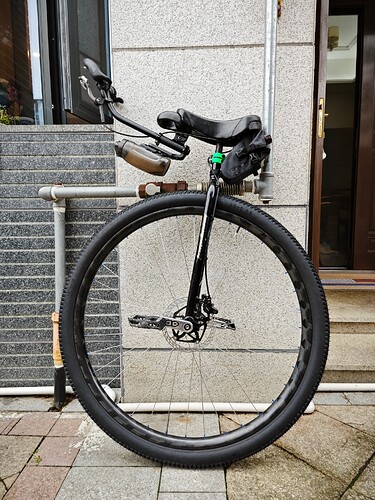This is the third publicly available 36" carbon rim to the best of my knowledge, and probably the only sensible choice by far. The previous products are either too expensive, difficult to find, or having compatibility issues. Thanks to the hard work of Light Bicycle in collaboration with the unicycle community, this rim works perfectly with the Nimbus Nightrider (Lite) tire, which is the most common 36" tire in the market amongst the very few choices. It’s readily available, with a reasonable price starting at $375.
For starters credit goes to Light Bicycle for even making this rim. 36" rims, mostly used on unicycles, are deemed not profitable as it’s for such a niche sport - I can’t even imagine that they can break even. I don’t fully get the idea why they are even doing this but to be honest, they have done a great job, at least as well as their other rim products, which already have a great reputation in the bicycle world.
Some basic facts: the Light Bicycle Unicus 36" rim, its basic version weighs at ~580g, that’s 600g lighter than Nimbus’ Dominator 2 rim (aluminum). It has 36 spoke holes so that it fits with most unicycle hubs (I’m pretty sure they can customize for 32 holes as well). It’s also the first 36" carbon rim (maybe any material of 36" rim in general) that features an asymmetrical design, which is huge for wheels with inboard disc. It has a hooked design to provide great compatibility with the clincher tires, which all current 36" tires are.
I have selected the Braided UD pattern for a fancier look, which makes it 50g more heavier than the basic version. The workmanship is great. I can see a few carbon threads in the spoke holes but nothing more than that. The finish is impeccable. The braided pattern looks fantastic, especially in the sun. I accidentally ordered silver spokes instead of black, but it actually looked surprisingly stylish pairing with the rim - the rim acted as a visually pleasing bridge between the matte black tire and the shiny silver spokes.
Building the wheel was straightforward, but the rim and the Nimbus Nightrider Lite tire has a very tight fit, I had to get help from the local bicycle store to have it installed - this however gave me confidence that it won’t fail like the previous 36" carbon rim product (from another brand) that we had high hope to, but that’s another story. With the Nimbus 125mm aluminum disc hub, Nightrider Lite tire, TPU tube from 36pollici.it, steel spokes and a carbon+steel disc, the completed wheel weighs at 2.84kg (without cranks/pedals), that’s about 1kg lighter than the stock Oracle 36 wheel.
As rotational momentum - the acceleration effort - is proportional to the diameter squared, IMO 36" wheels are those which need carbon rims the most. 1kg reduction of rotation mass is huge for a 36" wheel. By far I’ve had four 20-40km rides on this wheel (on my Oracle 36 frame, with 118mm cranks). In the beginning I had to take a few minutes to adapt to the change, but after that I really enjoyed the new performance. It’s more like riding a 29er, the unicycle becomes much more responsive and easier to handle, I can get to cruising speed much faster, as well as slowing down easier. I can turn sharp corners smoother at speed. It also made mounting easier. The downside, of course, is that I have to put in more effort to maintain speed - the lighter wheel slows down much easier if I don’t eagerly drive it. I also feel it’s a stiffer wheel - maybe the TPU tube also contributes to it. It transmits more details of the road to me. This, along with the reduced flywheel effect, could potentially increased fatigue on extended rides, but it’s yet to be observed.
Finally I really appreciated the customer service of Light Bicycle. They are very humble and responsive, and offered great help in my building.
As a conclusion, I’m very happy with this new rim (and the new build in general). It’s light, performant, well-thoughtout, well-built and reasonably priced. 5/5 would recommend if you are into 36ers.
For reference: when pairing with the Nimbus 125mm aluminum hub, this rim uses 363.5mm spokes on the disc side, 365.5mm on the non-disc side. The rim’s “larger” arc should be facing the disc side when building a unicycle wheel.

